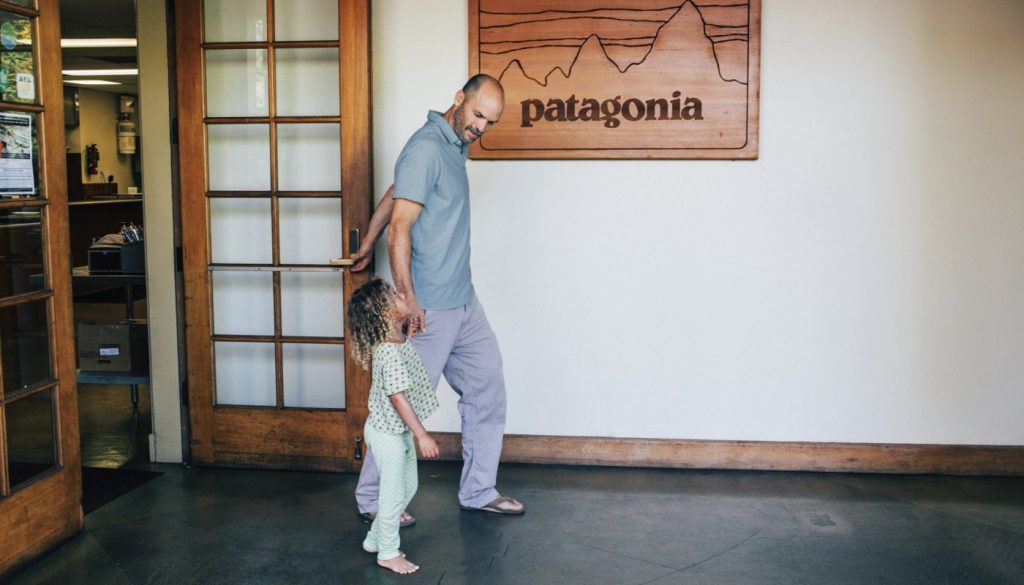Patagonia’s On-Site Child Care Results in Increased Gender Equality
By Olivia Totten
New families face many decisions, and choosing when, how, and who goes back to work can be extremely stressful. Many parents have to choose between experiencing their child’s first milestones or returning to work to financially support their family. Patagonia, the United States based clothing company, makes these decisions easier for their employees by offering two on-site child care centers in California called the Great Pacific Child Development Center and Nevada the Truckee River Child Development Center.
At their corporate headquarters in Ventura, California, employees can visit their children throughout their day to play with, feed, and rock their kids to sleep. Initially started in 1983, the on-site child care center now has 28 employees. The company expanded this model to their 400-employee distribution center in Reno, Nevada and currently serves 80 children in total. In locations without the on-site child care centers, Patagonia provides stipends to help their employees afford child care near them. Their goal is to integrate work and family life, making it easier for parents to return to work.
Parents at Patagonia find that having their child only steps from their office helps mitigate the challenges they face balancing work and parenting. Parents can see their child’s first milestones, and moms can breastfeed on-demand with quiet lactation rooms. They can even bring their work with them while spending time with their child. School-aged children are also transported to the company’s building after school for valuable parent-child bonding time. Parents can spend daily time with their kids, which parents say makes them more productive and lightens their mood. Having other employee’s kids playing with their children also creates a sense of community amongst the employees and kids, improving corporate culture.
Not only does on-site child care improve the lives of its employees, but it helps improve gender equality within the workplace, too. Taking years off to raise children can put women at a disadvantage for reaching senior management positions and equal pay. In the USA, 43% of pregnant women do not return to work full time. At Patagonia, 95% of mothers returned to their jobs full time. With their child just steps from their office, mothers can come back to work earlier and do not have to choose between work and family. For fathers, they can participate in their child’s daily life more, encouraging equal parenting from both mothers and fathers.
So, how does Patagonia pay for this one million dollar a year program? Parents have to pay tuition to use the service, which is subsidized for lower-income employees. This tuition covers about 40% of the cost of the program. Government tax abatements for qualified child care facilities pay for another 30% of the costs. Patagonia claims that 21% of the program is paid for by their increased retention and productivity as a result of the program. Indeed, it costs Patagonia 150% of their employee’s salary to replace that employee with another one.
 When mothers feel supported by the company to return to work and stay there, the company saves money by retaining that employee. For parents who use the child care center, their turnover rate is 25% less than the general employee population.
When mothers feel supported by the company to return to work and stay there, the company saves money by retaining that employee. For parents who use the child care center, their turnover rate is 25% less than the general employee population.
For the program, only 9% of the cost is not recouped.
Patagonia has managed to not only implement an on-site child care center but also paid maternal and paternal leave in a country that does not guarantee any paid parental leave. In the United States, only 14% of workers have access to paid parental leave. At Patagonia, however, new mothers get 16 weeks’ maternal leave with full pay, and new fathers and adoptive mothers get 12 weeks of full pay. All employees additionally get 12 weeks paid leave for serious medical conditions for themselves, child, spouse, partner, or parent. When parents must travel for work, Patagonia also pays for a nanny, child-care center teacher, or their partner to join them with their child.
Patagonia has managed to successfully address many obstacles women face in the workplace by implementing these various policies and programs. Their policies have resulted in increased gender equality in the company; 50% of managers are women, and 50% of senior-level management are women too. CEO Rose Marcario explains this idea, “We wonder why in corporate America women are absent at these levels. But the answer is really not that difficult, or expensive. You have to value caregiving”. Patagonia can successfully implement these policies in a country that provides no financial help for parental leave because they have made caregiving their priority.
1 https://www.patagonia.com/blog/2016/08/why-should-employers-care-about-families/
3 https://www.youtube.com/watch?time_continue=114&v=TzIVzV702Z8
4 https://www.youtube.com/watch?time_continue=222&v=pgeb-eU6LUw
5 https://www.youtube.com/watch?v=aPw20oIstx8
7 https://www.youtube.com/watch?time_continue=7&v=3LFJCvOfmV8
